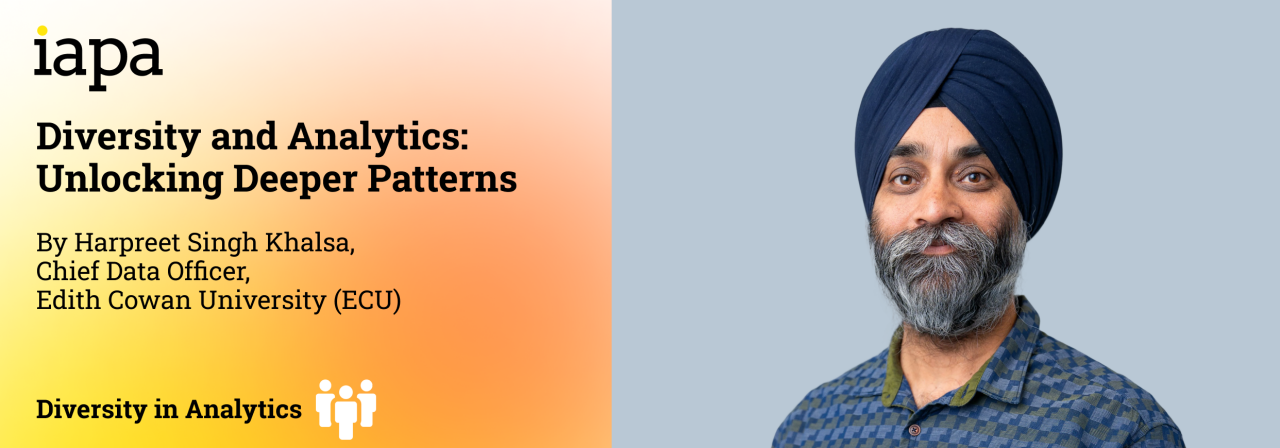
Diversity and Analytics: Unlocking Deeper Patterns
By Harpreet Singh Khalsa, Chief Data Officer at Edith Cowan University (ECU)
The Intersection of Data and Humanity
Diversity in Analytics isn’t a strategy - It’s a responsibility for every leader.
Diversity is no longer a corporate ideal; it is both a moral imperative and a performance enabler in analytics. In a world increasingly defined by data, the question is no longer whether we need diversity, but how consciously we embed it into every stage of insight generation.
Data itself is inherently neutral - it captures reality without bias or preference, but it cannot speak for itself. It is people who give data its voice, its story, and its meaning. When the teams interpreting that data lack diversity, the narratives that emerge can easily become skewed, incomplete, or self-reinforcing.
The rise of AI has brought this challenge into sharp focus. Ethics and accountability have become central to every discussion, reminding us that technology without diversity is innovation without empathy. When technical capabilities are developed in isolation from diverse human experiences, they risk amplifying bias instead of reducing it.
We are already witnessing the consequences - alienation of generation as opposed to deeper connection, and algorithms that reinforce fragility instead of resilience. Involving youth, young parents, people of faith, genders, first nation voices, and culturally diverse communities in the design and governance of AI would not only have ensured fairer outcomes but also created technologies that serve humanity in its full spectrum.
Diversity, therefore, is not just a checkbox for inclusion - it is the cornerstone of ethical intelligence and the compass that keeps analytics aligned with human values.
Linguist Context and Etymology of Diversity and Analytics
Before we go any further into the concept, it’s imperative that we understand the roots of two critical words that will be focal point of this article - Diversity and Analytics.
The word diversity originates from the Latin diversitas, meaning difference, variety, or separateness. In today’s context, it represents the inclusion of individuals from varied backgrounds - each bringing their own experiences, values, and ways of thinking.
Analytics, on the other hand, comes from the Ancient Greek analytikós - “to loosen” or “to resolve into constituent elements.” Originally, it referred to the branch of logic concerned with distinguishing sound reasoning from flawed arguments.
When viewed together, these origins reveal a profound truth: It is through diversity that analytics learns to distinguish not just between patterns in data, but between what truly serves or harms humanity. A broader understanding of “good” and “bad” emerges only when people from diverse backgrounds come together - sharing their histories, cultures, and lived experiences. These collective insights help teams recognise the deeper factors behind past successes and failures. Such varied perspectives and human understanding is what will drive meaningful and ethical innovation in Analytics and AI. The foundation of a prosperous future, therefore, rests upon the lessons of our shared history, values and common understanding.
Why Diversity Matters in Analytics
Analytics is not just about processing data - it’s about interpreting context. Diverse teams bring a variety of mindsets, belief systems, and cultural perspectives that help uncover deeper patterns and connections within data.
If everyone on a team thinks and believes in the same way, they will interpret the data in the same way - leading to uniform decisions and diminishing any competitive advantage that comes from unique insight. In such cases, analytics becomes mechanical, reducing the very human element that gives meaning to the numbers.
Organisations that genuinely embrace diversity - across culture, gender, religion, background, and lived experience - will consistently outperform those that treat it as a compliance measure. They don’t just analyse data better; they understand people better - hence higher value for stakeholders.
Diversity also helps us architect, design and develop data solutions in different ways. People with diverse backgrounds think differently and bring ideas to the table that help us understand the various challenges we may face in developing data solutions. This diversity helps us design a unique architecture that can help us in pre-empting the challenges; designing dashboards and reports in a way that helps a variety of people to connect with the insights. For example, having people with a disability as part of the team may help us develop solutions that are relevant to a broader community.
Diversity exponentially expands the horizon of our solutions and their relevance to different stakeholders - which is critical for organisations that are dealing with the community at large.
Data Itself Is Diverse
Our society today is more multicultural than ever before - and our data reflects this. Each dataset carries within it the stories of people from different walks of life.
If our analytics teams lack representation from this diversity, we risk missing key insights. For example, in a food retail business, if analysts only understand Western cultural patterns, they might overlook a sales spike in October that coincides with Indian festive seasons. That’s not just a missed analytical observation - it’s a missed business opportunity to serve customers more meaningfully. It will be same in the case of Lunar festivals or festive seasons that are linked to South-East Asian cultures.
Globalisation is not just limited to business transactions; it reflects in our data too and that automatically leaves us with no option but to have data teams that represent a globe that is filled with amazing cultures and diversity.
Beyond Representation: From Multi-Coloured to Multi-Cultural Teams
Having people from different backgrounds is not the same as having diversity that works. The real power of diversity is unlocked when people feel safe and supported to share their perspectives freely - without fear of bias, judgement, or the pressure to conform.
As leaders it’s our responsibility to ensure that we are just not ticking the Human Resource departments KPI of Diversity by building multi-coloured and gendered teams. Multi-cultural diversity goes much further, and this is where leaders play the role. The journey from multi coloured to multi culture is hard but at the same time rewarding, enriching and exciting. Here are some of points that can help us understand the difference between both.
Multi-Coloured Diversity |
Multi-Cultural Diversity |
Diversity is visible, but not integrated |
Diversity is lived and felt |
Representation exists, but collaboration is limited |
Collaboration is natural and inclusive |
Decisions flow one way: “This is how I work.” |
Decisions are co-created |
Diversity is treated as a KPI |
Diversity drives every KPI |
Like a palette of colours never blended |
A canvas painted with intention — every shade adds depth |
Decision-Making in Diverse Teams
At its core, analytics is about decision-making; either the analytics team is making the decisions about Analytics or enabling the decisions within business that are underpinned by the Analytics. Diversity naturally brings a range of opinions, and sometimes that makes decision-making more complex - but that’s where leadership values become critical.
As leaders, our role is to ensure the team’s values take precedence over individual preferences. Diversity is about bringing variety of thought, but also about accepting that the final decision may not always align with one’s own view.
From my personal experience, I believe the strength of analytics leadership lies in upholding values of respect, objectivity, fairness, and servant leadership. When diversity is guided by these principles, it doesn’t create confusion - it creates clarity. It transforms data into understanding and understanding into impact.
Leadership is also about ensuring that decisions are made where the information is - enabling everyone to make decisions that are relevant to the role they conduct. This will automatically bring diversity in decisions as far as organisational values are being followed.
Learnings as Chief Data Officer
At ECU, I have been fortunate to work with a leadership team that not only recognises the strategic value of diversity in Analytics but actively empowers it. Their confidence in entrusting a first-generation migrant to lead such a critical portfolio reflects the institution’s deep commitment to inclusion - not as a policy statement, but as a lived principle. That trust has been a defining source of motivation for me to ensure that the same spirit of diversity is embedded across every layer of our data ecosystem.
Our Data and Analytics team today represents what true diversity can achieve - a strong representation of women in data roles, and a rich mix of cultural, educational, and faith-based backgrounds. This diversity does more than fulfil representation goals; it sharpens our analytical perspectives, enriches our problem-solving capacity, and fosters a culture of psychological safety and creativity.
Another often-overlooked dimension of diversity lies in the balance between experience and emerging talent. Seasoned professionals bring strategic vision, contextual understanding, and depth of insight, while less experienced team members contribute fresh perspectives, creativity, and energy. When these strengths are intentionally balanced, the result is a team that delivers innovative solutions with agility, efficiency, and long-term sustainability.
As Chief Data Officer, I see my role not merely as a custodian of data assets but as an enabler of collective intelligence. The success of our portfolio is powered not by individual brilliance but by the diversity of thought, experience, and empathy that each member of our team contributes. It is this human diversity that transforms data into wisdom - and analytics into meaningful impact.
Closing Thought
I would like to conclude with a few reflections drawn from my journey as Chief Data Officer - lessons that continue to shape how I view the intersection of diversity and analytics:
- Diversity and analytics are inseparable. The moment we treat them as separate concepts, we distance ourselves from realising the full potential of our investments in data, technology, and insight-driven decision-making.
- Diversity begins with representation, but it thrives through culture. Building a multi-coloured team is only the starting point. The true leadership challenge lies in evolving it into a genuinely multi-cultural environment - one where every voice feels safe, valued, and heard.
- Empowerment is the foundation of inclusion. A diverse team reaches its full potential only when people are trusted to make decisions and contribute freely, without being constrained by hierarchy or control.
- Seek the ‘why’ behind diverse perspectives. Diversity is not just about differing ideas - it’s about understanding the lived experiences and rationales that shape those ideas. True inclusion happens when we listen to the story behind the suggestion, not just the suggestion itself, and apply into our lives.
Diversity in analytics is not merely a strategy - it is a responsibility. As data leaders, our role is to ensure that every insight reflects not just the numbers we see, but the humanity we represent.
* Author acknowledges the use of AI to refine some of the concepts in this article.
About the Author
Harpreet Khalsa is the Chief Data Officer at Edith Cowan University, with a career spanning over three decades - from the early days of Dbase and Foxbase to today’s modern platforms like Dataverse, Databricks, and everything in between. His professional passion lies in decoding the complexities of business decisions and leveraging data to bring clarity, insight, and meaningful impact.
Under his leadership, ECU’s Data and Analytics team has received multiple recognitions, including the Vice-Chancellor’s Inspirational Team Award. He has been amongst IAPA’s Top 25 Analytics Professionals in 2022, and selection as Finalists for the Sikh Awards in the professional category in 2023. Data platforms architected and developed by his team have been researched and acknowledged by Gartner.
Beyond his professional pursuits, Harpreet has conceptualised and narrated a documentary on Virtual Reality and Spirituality - Jaagdi Neend, exploring the intersection of technology and faith. He was also invited by the United Nations (COP28) to speak on the Environmental Crisis and the role of faith in fostering sustainable solutions.
Deeply committed to community engagement, Harpreet regularly conducts sessions with first-generation migrants, helping them recognise and harness their cultural strengths to navigate and thrive amidst the challenges of modern life.
